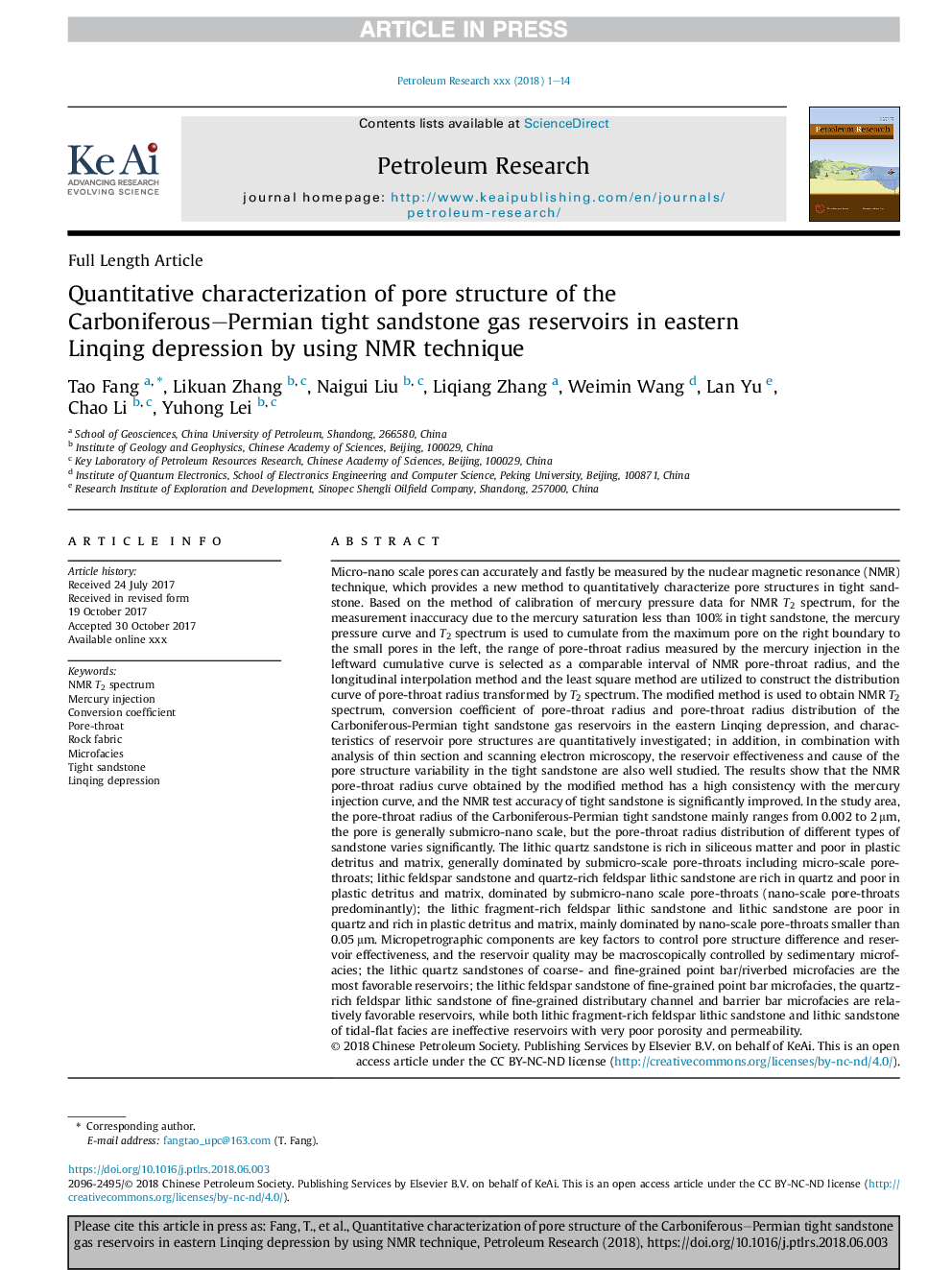| کد مقاله | کد نشریه | سال انتشار | مقاله انگلیسی | نسخه تمام متن |
|---|---|---|---|---|
| 8918289 | 1642829 | 2018 | 14 صفحه PDF | دانلود رایگان |
عنوان انگلیسی مقاله ISI
Quantitative characterization of pore structure of the Carboniferous-Permian tight sandstone gas reservoirs in eastern Linqing depression by using NMR technique
دانلود مقاله + سفارش ترجمه
دانلود مقاله ISI انگلیسی
رایگان برای ایرانیان
کلمات کلیدی
موضوعات مرتبط
مهندسی و علوم پایه
علوم زمین و سیارات
زمین شناسی
پیش نمایش صفحه اول مقاله

چکیده انگلیسی
Micro-nano scale pores can accurately and fastly be measured by the nuclear magnetic resonance (NMR) technique, which provides a new method to quantitatively characterize pore structures in tight sandstone. Based on the method of calibration of mercury pressure data for NMR T2 spectrum, for the measurement inaccuracy due to the mercury saturation less than 100% in tight sandstone, the mercury pressure curve and T2 spectrum is used to cumulate from the maximum pore on the right boundary to the small pores in the left, the range of pore-throat radius measured by the mercury injection in the leftward cumulative curve is selected as a comparable interval of NMR pore-throat radius, and the longitudinal interpolation method and the least square method are utilized to construct the distribution curve of pore-throat radius transformed by T2 spectrum. The modified method is used to obtain NMR T2 spectrum, conversion coefficient of pore-throat radius and pore-throat radius distribution of the Carboniferous-Permian tight sandstone gas reservoirs in the eastern Linqing depression, and characteristics of reservoir pore structures are quantitatively investigated; in addition, in combination with analysis of thin section and scanning electron microscopy, the reservoir effectiveness and cause of the pore structure variability in the tight sandstone are also well studied. The results show that the NMR pore-throat radius curve obtained by the modified method has a high consistency with the mercury injection curve, and the NMR test accuracy of tight sandstone is significantly improved. In the study area, the pore-throat radius of the Carboniferous-Permian tight sandstone mainly ranges from 0.002 to 2â¯Î¼m, the pore is generally submicro-nano scale, but the pore-throat radius distribution of different types of sandstone varies significantly. The lithic quartz sandstone is rich in siliceous matter and poor in plastic detritus and matrix, generally dominated by submicro-scale pore-throats including micro-scale pore-throats; lithic feldspar sandstone and quartz-rich feldspar lithic sandstone are rich in quartz and poor in plastic detritus and matrix, dominated by submicro-nano scale pore-throats (nano-scale pore-throats predominantly); the lithic fragment-rich feldspar lithic sandstone and lithic sandstone are poor in quartz and rich in plastic detritus and matrix, mainly dominated by nano-scale pore-throats smaller than 0.05â¯Î¼m. Micropetrographic components are key factors to control pore structure difference and reservoir effectiveness, and the reservoir quality may be macroscopically controlled by sedimentary microfacies; the lithic quartz sandstones of coarse- and fine-grained point bar/riverbed microfacies are the most favorable reservoirs; the lithic feldspar sandstone of fine-grained point bar microfacies, the quartz-rich feldspar lithic sandstone of fine-grained distributary channel and barrier bar microfacies are relatively favorable reservoirs, while both lithic fragment-rich feldspar lithic sandstone and lithic sandstone of tidal-flat facies are ineffective reservoirs with very poor porosity and permeability.
ناشر
Database: Elsevier - ScienceDirect (ساینس دایرکت)
Journal: Petroleum Research - Volume 3, Issue 2, June 2018, Pages 110-123
Journal: Petroleum Research - Volume 3, Issue 2, June 2018, Pages 110-123
نویسندگان
Tao Fang, Likuan Zhang, Naigui Liu, Liqiang Zhang, Weimin Wang, Lan Yu, Chao Li, Yuhong Lei,